Salesforce Certified MuleSoft Developer (Mule-Dev-201) Exam Practice Test
Refer to exhibits.
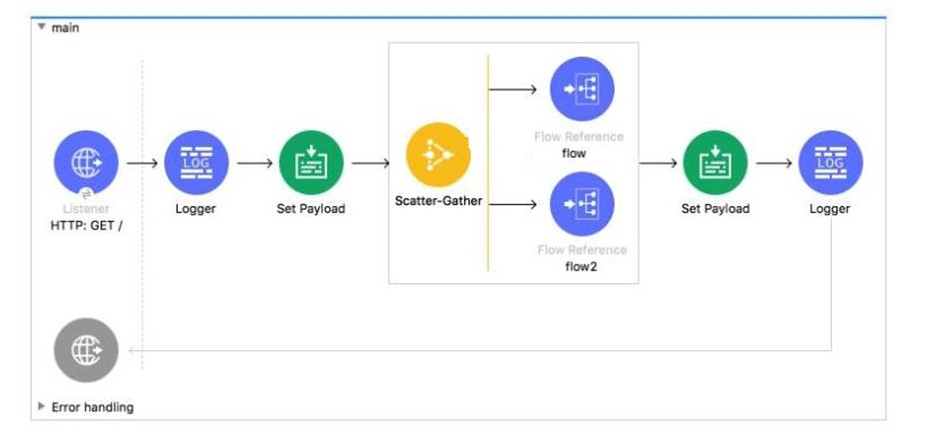
In the execution of the Scatter-Gather , the flow route completes after 10 seconds and the flow2 route completes in 40 seconds. How many seconds does it take for the Scatter-Gather to complete?
Answer : C
Scatter-Gather sends the event to each routes concurrently. Hence both route in this example will start in parallel. So total time to complete processing is 40 seconds
The Scatter-Gather component is a routing event processor that processes a Mule event through different parallel processing routes that contain different event processors. Each route receives a reference to the Mule event and executes a sequence of one or more event processors. Each of these routes uses a separate thread to execute the event processors, and the resulting Mule event can be either the same Mule event without modifications or a new Mule event with its own payload, attributes, and variables. The Scatter-Gather component then combines the Mule events returned by each processing route into a new Mule event that is passed to the next event processor only after every route completes successfully.
The Scatter-Gather component executes each route in parallel, not sequentially. Parallel execution of routes can greatly increase the efficiency of your Mule application and may provide more information than sequential processing.
Mule Ref Doc :https://docs.mulesoft.com/mule-runtime/4.3/scatter-gather-concept
Refer to the exhibits.
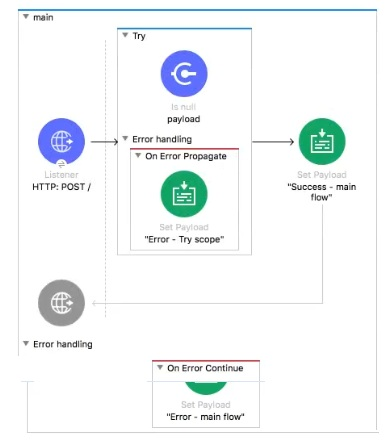
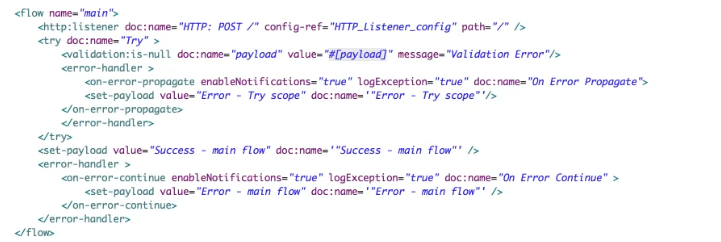
The Validation component in the Try scope throws an error.
What response message is returned to a client request to the main flow's HTTP Listener?
The Validation component in the Try scope throws an error. What response message is returned to a client request to the main flow's HTTP Listener?
Answer : A
Note that private flow has error scope defined as On Error Continue . So when error occurs in private flow , it is handled by this On Error Continue scope which sends success response back to main flow and does not throw back an error. So main continues normally and payload is set to Success - main flow.
Hence correct answer isSuccess - main flow
1) HTTP listener received request
2) The Flow Reference calls the child flow
3) The Is Number validator creates an Error Object because the payload isn't an integer. Child Flow execution stops
#[error.description] = ''payload is not a valid INTEGER value''
#[error.errorType] = VALIDATION:INVALID_NUMBER
4) The On Error Continue handles the errorThe payload is set to ''Error -- Sub Flow''
5) ''Error -- Sub Flow'' is returned to the main flow as if the child flow was a success. The Set Payload is executed. The payload is reset to ''Success -- Finished Main Flow''
6) ''Success -- Main Flow'' is returned to the requestor in the body of the HTTP request. HTTP Status Code: 200
As you can see, in the above example, because the error was caught by an On Error Continue scope in the child flow (RED in, GREEN out) when the Mule Message returns to the parent flow, the parent flow knows none-the-different that there was a failure because the on error continue returns a 200 success message. Note that because, to the mainFlow, the childFlow appeared to succeed, the processing of mainFlow resumed after the flow reference.

Refer to the exhibits.
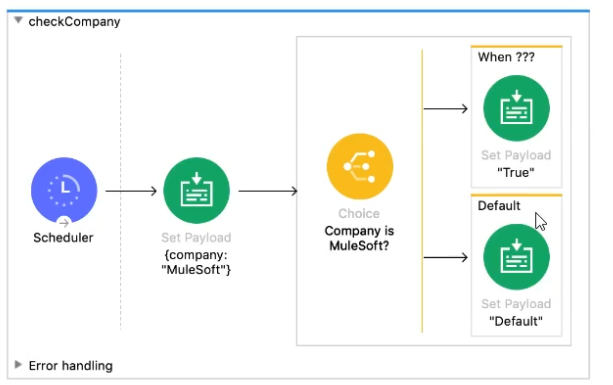

The
What is a valid
Answer : A
Refer to the exhibit.

In the execution of the Scatter_Gather, the flow1 route completes after 10 seconds and the flow2 route completes after 20 seconds.
How many seconds does it take for the Scatter_Gather to complete?
Answer : C
Refer to the exhibits.
A web client sends sale data in a POST request to the Mule application. The Transform Message component then enrich the payload by prepending a vendor name to the sale data.
What is written to the sales.csv file when the flow executes?
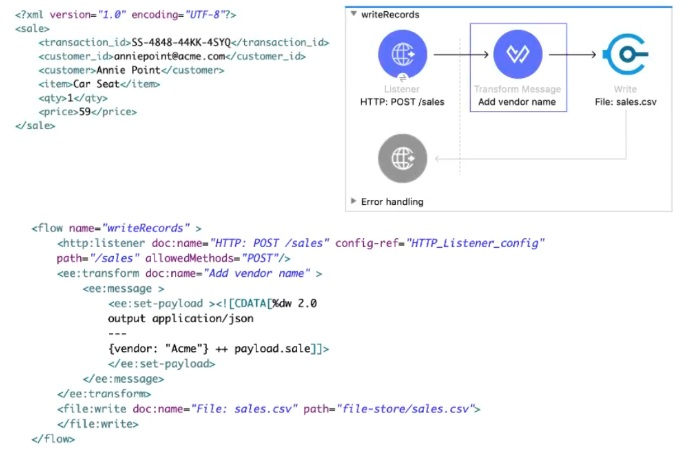
Answer : A
Refer to the exhibits.
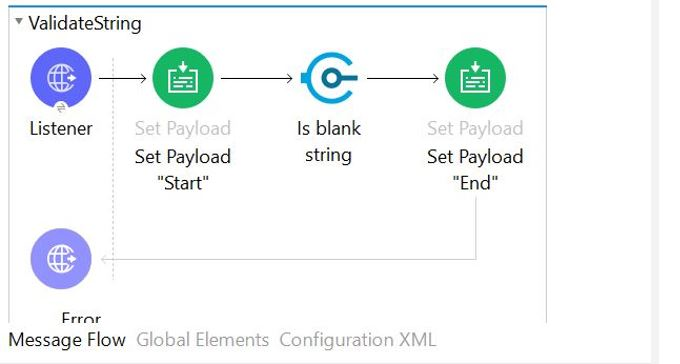

A web client submits the request to the HTTP Listener. What response message would be returned to web client?
Answer : B
Correct answer is String is not blank.
-------------------------------------------------------------------------------------------------------------------------------------------------
Here's specifically what is happening here:
1) Payload is successfully set to ''Start''
2) The Is Blank String validator creates an Error Object because the payload is string 'Start'. Execution stops
#[error.description] = ''String is not blank''
3) Because no error handler is defined, the Mule default error handler handles the error. Remember, at its heart, the Mule Default Error handler is an error handling scope with just an on error propagate
4) ''String is not blank'' is the error message returned to the requestor in the body of the HTTP requestHTTP Status Code: 500
Reference Diagram:
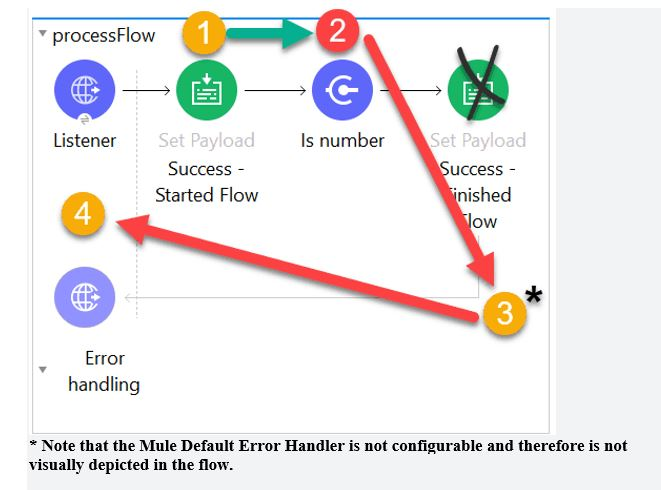
Refer to the exhibit.

What DataWeave expression transforms the conductorlds array to the XML output?
A)

B)

C)

D)

Answer : C